|
Local History of Gold Mining
 Gold was first discovered in the Sherbrooke area in 1861 when Nelson Nickerson discovered it on his farm in Goldenville while he was making hay. It wasn't until October 18 of the same year that the news of his find became widespread. 200 people flocked to Goldenville to stake their claims, and by 1869 there were nineteen companies mining in the area. Four of those companies produced 85% of the gold. Additional gold veins were discovered in the province around the same time, including a find in Tangier in 1858 and finds in Oldham, Wine Harbour, Stormont, Waverly, Cochran Hill, and Forest Hills in 1861. Gold was first discovered in the Sherbrooke area in 1861 when Nelson Nickerson discovered it on his farm in Goldenville while he was making hay. It wasn't until October 18 of the same year that the news of his find became widespread. 200 people flocked to Goldenville to stake their claims, and by 1869 there were nineteen companies mining in the area. Four of those companies produced 85% of the gold. Additional gold veins were discovered in the province around the same time, including a find in Tangier in 1858 and finds in Oldham, Wine Harbour, Stormont, Waverly, Cochran Hill, and Forest Hills in 1861.
 By 1871 the mining in Goldenville had proved to not be as prosperous as in other areas of the province. Only six companies remained by that year. By 1871 the mining in Goldenville had proved to not be as prosperous as in other areas of the province. Only six companies remained by that year.
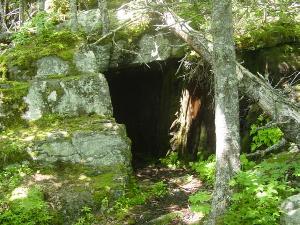
Local Test Shaft
 Miners originally mined the gold from quartz with picks and shovels. In the 1800's steel drills were used instead to make the work faster and easier. Dynamite was introduced in 1872 to the mines. Prior to this, blasting powder was used. The powder was not efficient, it did not break the rocks up sufficiently and threw the rock around considerably. To see underground, miners used carbide lamps on their helmets. Wages paid to miners in 1872 were $1.25 - $1.50 for an 8 hour work day. In 1930, $2.40 was paid for an 8 hour work day, although some miners worked for 10-12 hours for the same pay. Miners originally mined the gold from quartz with picks and shovels. In the 1800's steel drills were used instead to make the work faster and easier. Dynamite was introduced in 1872 to the mines. Prior to this, blasting powder was used. The powder was not efficient, it did not break the rocks up sufficiently and threw the rock around considerably. To see underground, miners used carbide lamps on their helmets. Wages paid to miners in 1872 were $1.25 - $1.50 for an 8 hour work day. In 1930, $2.40 was paid for an 8 hour work day, although some miners worked for 10-12 hours for the same pay.
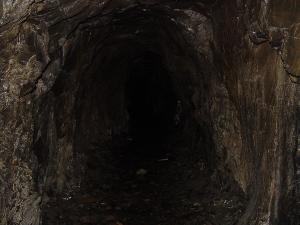
Inside of Test Shaft
 A shaft house was built over the open shaft that went deep into the ground. The shaft went straight down and then branched off in different directions and also at different levels. Men would be raised with the ore in large barrels or wheel barrows. The ore would then be dumped into trolley carts. A shaft house was built over the open shaft that went deep into the ground. The shaft went straight down and then branched off in different directions and also at different levels. Men would be raised with the ore in large barrels or wheel barrows. The ore would then be dumped into trolley carts.
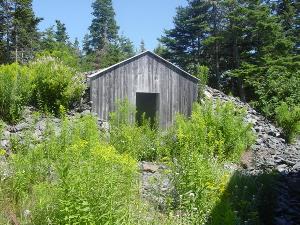
Shaft House
 The trolley carts would be pushed over to a large table that had a grate on it. This was called the picking table. Men would stand on free floating boards which could be moved back and forth, then they would use sledge hammers and break the rocks small enough to fit through the grate. The ore had to be about 5 cm (2 inches) in diameter before it could be put through the stamps. After falling through the grate, the small pieces of rock would flow down a chute into the ore bins. The bins would have to be opened to let a steady flow of ore through. From the bins, the ore would have been mixed with a flowing supply of water which would go under the stamp mill. The trolley carts would be pushed over to a large table that had a grate on it. This was called the picking table. Men would stand on free floating boards which could be moved back and forth, then they would use sledge hammers and break the rocks small enough to fit through the grate. The ore had to be about 5 cm (2 inches) in diameter before it could be put through the stamps. After falling through the grate, the small pieces of rock would flow down a chute into the ore bins. The bins would have to be opened to let a steady flow of ore through. From the bins, the ore would have been mixed with a flowing supply of water which would go under the stamp mill.
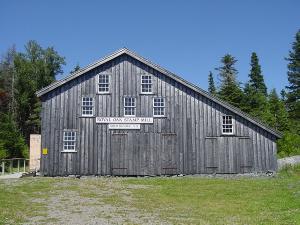
Stamp Mill
 As the ore went under the stamps it would be crushed into fine grains. Stamps of a typical mill weighed about 227-272 kg (500-600 lbs), fell 22-33 cm (10-15 inches) and would move up and down 50-75 times a minute. The crushed ore would then flow out onto a copper-based table called a sluice. A man would have to spread this table with mercury using a cloth, and then brush it to make small groves. Any fine gold flowing over the mercury stuck to it and stayed until it was scraped off with a flat utensil. The tables would be cleaned every three to four days depending on the amount of ore that was crushed and how gold-rich it was. The mercury and gold remnants would be placed in a sack made of closely woven cloth and mercury would be removed by pressing the cloth. The mercury would then be reused. What was left was placed in the retorting pot. Pots were lined with clay and water to keep the gold from sticking. The pots would be placed in a forge and boiled at an intense heat so any remaining mercury would evaporate. The gold remained in the pot in the form of a spongy mass. It was then placed in melting pots (crucibles) and cast into ingots. As the ore went under the stamps it would be crushed into fine grains. Stamps of a typical mill weighed about 227-272 kg (500-600 lbs), fell 22-33 cm (10-15 inches) and would move up and down 50-75 times a minute. The crushed ore would then flow out onto a copper-based table called a sluice. A man would have to spread this table with mercury using a cloth, and then brush it to make small groves. Any fine gold flowing over the mercury stuck to it and stayed until it was scraped off with a flat utensil. The tables would be cleaned every three to four days depending on the amount of ore that was crushed and how gold-rich it was. The mercury and gold remnants would be placed in a sack made of closely woven cloth and mercury would be removed by pressing the cloth. The mercury would then be reused. What was left was placed in the retorting pot. Pots were lined with clay and water to keep the gold from sticking. The pots would be placed in a forge and boiled at an intense heat so any remaining mercury would evaporate. The gold remained in the pot in the form of a spongy mass. It was then placed in melting pots (crucibles) and cast into ingots.
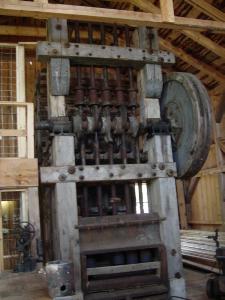
Rock Crusher
 Approximately ½ of Nova Scotian gold came from the mine in Goldenville. There were 136 buildings in Goldenville plus a Roman Catholic Church. Mines in Goldenville were worked somewhat during World War II but were abandoned again in 1942. Approximately ½ of Nova Scotian gold came from the mine in Goldenville. There were 136 buildings in Goldenville plus a Roman Catholic Church. Mines in Goldenville were worked somewhat during World War II but were abandoned again in 1942.
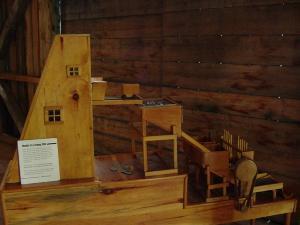
Stamp Mill Mock-up
[Go Back]
|





